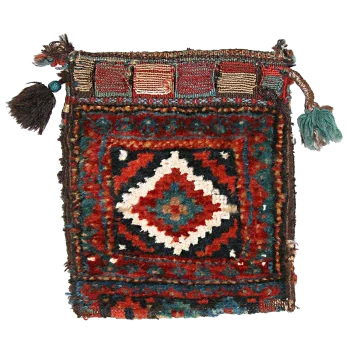
The New England Rug Society
Presents an ACOR 8 Exhibition
Small Weavings of the South Persian Nomads
An Introduction to the Exhibition
by Ann Nicholas & Richard Blumenthal
South Persian nomads were among the most prolific of weavers, making both pile pieces and flat weaves. Piled bag faces may be the best known and loved of their weavings in the West, but their many small, colorful utilitarian bags were what most enhanced the nomads’ own lives. The original ACOR exhibit presented thirty-one small South Persian pieces and fifty historical photographs of weavings being used in South Persian life.
Twice a year these nomadic sheepherders made an epic migration, traveling more than a hundred miles with all their flocks and household possessions between their summer pastures high in the Zagros Mountains and winter ones in the foothills. Their weavings provided transport and storage for their possessions, color and beauty in their lives, and status and prestige to the weavers.
A nomadic family’s wealth was measured by the number of fine weavings and sheep they possessed, so it is not surprising that colorful, beautifully decorated woven articles were displayed prominently in their tent or on their pack animals.
The historical photographs in the original exhibition were found in books, many of which were old, rare, or out of print; in university and museum archives; and in the private collections of ethnographers. Correlated with information in ethnographic studies of the South Persian nomads, these photographs provided an understanding of how woven objects were used. Unfortunately, while they were integral in giving context to the weavings, most of them cannot be included in this web exhibition due to copyright restrictions.
Visitors to this web site can enjoy these weavings for what they are: wonderful works of art with great color, imaginative use of design, and fine workmanship. Alternatively, to better appreciate their cultural context, viewers can refer to our articles in HALI, issues 150 and 151 (2007). Whichever way you choose to experience this exhibition, enjoy it!





































